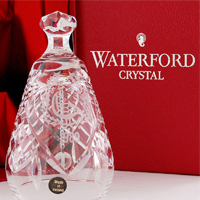Belleek Irish Porcelain
In 1849, John Caldwell Bloomfield inherited the Castle Caldwell estate from his
father. The estate encompassed the village of Belleek. Because of the potato
famine and the plight of his tenant farmers, he wanted to provide them with some
form of worthwhile employment. After ordering a geological survey of his land,
it revealed the necessary raw materials to make pottery - feldspar, kaolin,
flint, clay and shale.
The Gaelic words 'beal leice' (Belleek) translates to flagstone ford. The village was a natural choice to locate the business, especially the part known as Rose Isle. This small island provided the best opportunity to use the River Erne to power a mill wheel strong enough to grind components into slip, which is the term applied to liquid potters clay.
Partnered with Robert Williams Armstrong, an architect from London interested in ceramics, and David McBirney, a wealthy Dublin merchant, Bloomfield laid out the plans for his pottery business. He practically paved the way single-handedly for the rail service to come to Belleek. This move allowed coal to be brought in to fire the kilns and the finished Belleek product could be sent to market with ease. With everything in place, he began construction of a pottery building and laid the corner stone on November 18, 1858.
Local apprentices and capable workmen were hired but success hinged on talented craftsmen and experienced potters. Armstrong went to England and, offering high wages and a better lifestyle, brought back fourteen craftsmen from Stoke-on-Trent.
Early production centered on high quality domestic ware, however, Armstrong and McBirney wanted to make porcelain showcasing the craftsmanship of their potters. They quickly developed the pottery but their early attempts failed. It was not until 1863 that a small amount of parian china was produced. Even though the knowledge and skill to create parian had been gained, the earthenware products remained their best sellers until 1920.
By 1865, the company had a growing market throughout Ireland and England and began exporting pieces to the United States, Canada and Australia. Orders were even received from Queen Victoria, the Prince of Wales and other nobility. With their display being the largest of the Irish and English industries, Belleek porcelain was featured for the first time at the Dublin Exposition of 1872.
The Gaelic words 'beal leice' (Belleek) translates to flagstone ford. The village was a natural choice to locate the business, especially the part known as Rose Isle. This small island provided the best opportunity to use the River Erne to power a mill wheel strong enough to grind components into slip, which is the term applied to liquid potters clay.
Partnered with Robert Williams Armstrong, an architect from London interested in ceramics, and David McBirney, a wealthy Dublin merchant, Bloomfield laid out the plans for his pottery business. He practically paved the way single-handedly for the rail service to come to Belleek. This move allowed coal to be brought in to fire the kilns and the finished Belleek product could be sent to market with ease. With everything in place, he began construction of a pottery building and laid the corner stone on November 18, 1858.
Local apprentices and capable workmen were hired but success hinged on talented craftsmen and experienced potters. Armstrong went to England and, offering high wages and a better lifestyle, brought back fourteen craftsmen from Stoke-on-Trent.
Early production centered on high quality domestic ware, however, Armstrong and McBirney wanted to make porcelain showcasing the craftsmanship of their potters. They quickly developed the pottery but their early attempts failed. It was not until 1863 that a small amount of parian china was produced. Even though the knowledge and skill to create parian had been gained, the earthenware products remained their best sellers until 1920.
By 1865, the company had a growing market throughout Ireland and England and began exporting pieces to the United States, Canada and Australia. Orders were even received from Queen Victoria, the Prince of Wales and other nobility. With their display being the largest of the Irish and English industries, Belleek porcelain was featured for the first time at the Dublin Exposition of 1872.
Disclaimer: LittleShamrocks.com is an affiliate website that receives commissions from sales of the products listed. We have purchased and sampled many, but not all, of the products on these pages.
© Copyright LittleShamrocks.com. All Rights Reserved.




